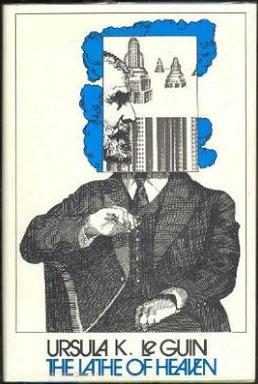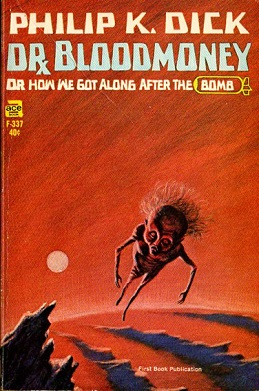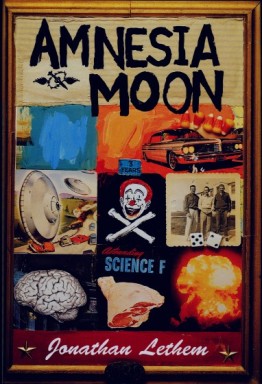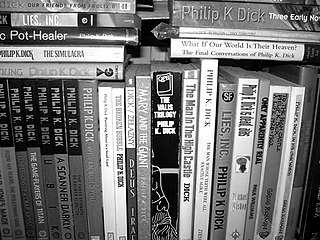
Kevin Wayne Jeter is an American science fiction and horror author known for his literary writing style, dark themes, and paranoid, unsympathetic characters. He has written novels set in the Star Trek and Star Wars universes, and has written three sequels to Blade Runner. Jeter coined the term "steampunks".

Philip Kindred Dick, often referred to by his initials PKD, was an American science fiction writer. He wrote 44 novels and about 121 short stories, most of which appeared in science fiction magazines during his lifetime. His fiction explored varied philosophical and social questions such as the nature of reality, perception, human nature, and identity, and commonly featured characters struggling against elements such as alternate realities, illusory environments, monopolistic corporations, drug abuse, authoritarian governments, and altered states of consciousness. He is considered one of the most important figures in 20th century science fiction.

A Scanner Darkly is a science fiction novel by American writer Philip K. Dick, published in 1977. The semi-autobiographical story is set in a dystopian Orange County, California, in the then-future of June 1994, and includes an extensive portrayal of drug culture and drug use. The novel is one of Dick's best-known works and served as the basis for a 2006 film of the same name, directed by Richard Linklater.

The Man in the High Castle (1962) is an alternative history novel by Philip K. Dick wherein the Axis Powers won World War II. The story occurs in 1962, fifteen years after the end of the war in 1947, and depicts the life of several characters living under Imperial Japan or Nazi Germany as they rule the partitioned United States. The titular character is the mysterious author of a novel-within-the-novel entitled The Grasshopper Lies Heavy, a subversive alternative history of the war in which the Allied Powers are victorious.

Humpty Dumpty is a character in an English nursery rhyme, probably originally a riddle and one of the best known in the English-speaking world. He is typically portrayed as an anthropomorphic egg, though he is not explicitly described as such. The first recorded versions of the rhyme date from late eighteenth-century England and the tune from 1870 in James William Elliott's National Nursery Rhymes and Nursery Songs. Its origins are obscure, and several theories have been advanced to suggest original meanings.

The Lathe of Heaven is a 1971 science fiction novel by American writer Ursula K. Le Guin. The plot concerns a character whose dreams alter past and present reality. The story was serialized in the American science fiction magazine Amazing Stories. The novel received nominations for the 1972 Hugo and the 1971 Nebula Award, and won the Locus Award for Best Novel in 1972. Two television film adaptations were released: the PBS production, The Lathe of Heaven (1980), and Lathe of Heaven (2002), a remake produced by the A&E Network.

The Divine Invasion is a 1981 science fantasy novel by American writer Philip K. Dick. It is the second book in the gnostic VALIS trilogy, and takes place in the indeterminate future, perhaps a century or more after VALIS. The novel, originally titled Valis Regained, was nominated to the BSFA Award.

Emmanuel Carrère is a French author, screenwriter and film director.
The Owl in Daylight is a novel Philip K. Dick was writing at the time of his death in 1982. He had already been paid an advance for the book by the publisher and was working against a deadline. After his death, his estate approached other writers about the possibility of someone completing the novel based on his notes, but that proved to be impossible, as he had never formally outlined the story. Dick viewed the novel as his Finnegans Wake. The idea was inspired partly by an entry in the Encyclopædia Britannica on Beethoven that referred to him as the most creative genius of all time, partly by traditional views of what constitutes the human heaven, and finally by the Faust story.
"The Last of the Masters" is a science fiction novelette by American writer Philip K. Dick. The original manuscript of the story was received by the Scott Meredith Literary Agency on July 15, 1953, and the story was published by the Hanro Corporation in the final issue of Orbit Science Fiction in 1954. It has since been reprinted in several Philip K. Dick story collections, beginning with The Golden Man in 1980.
"Pay for the Printer" is a science fiction short story by American writer Philip K. Dick. It was first published in Satellite Science Fiction, in October 1956. Manuscript dated January 28, 1954.

Humpty Dumpty is a fictional character from DC Comics. Unlike many of Batman's enemies, he is not deliberately malevolent, and is typically portrayed as comic relief.

Dr. Bloodmoney, or How We Got Along After the Bomb is a 1965 science fiction novel by American writer Philip K. Dick. It was nominated for the Nebula Award for Best Novel in 1965.

Amnesia Moon is a 1995 novel by Jonathan Lethem. Lethem adapted the novel from several unpublished short stories he had written, all about catastrophic, apocalyptic events. When Tor Books published the second edition in 1996, they commissioned Michael Koelsch to illustrate a new cover art; Koelsch had previously illustrated Lethem's previous book cover art Gun, with Occasional Music.

The bibliography of Philip K. Dick includes 44 novels, 121 short stories, and 14 short story collections published by American science fiction author Philip K. Dick during his lifetime.

Gather Yourselves Together is an early novel by the science fiction author Philip K. Dick, written around 1948–1950, and published posthumously by WCS Books in 1994. As with many of his early books which were considered unsuitable for publication when they were first submitted as manuscripts, this was not science fiction, but rather a work of straight literary fiction. The manuscript was 481 pages in length. At the time it was published, it was one of only two Dick novels for which the manuscript was known to exist which remained unpublished. The other, Voices from the Street, was published in 2007.

Puttering About in a Small Land is an early non-science fiction novel by American science fiction author Philip K. Dick. It was written sometime in 1957, but remained unpublished until it was released posthumously in 1985.

Humpty Dumpty in Oakland is a realist, non-science fiction novel authored by Philip K. Dick. Originally completed in 1960, but rejected by prior publishers, this work was posthumously published by Gollancz in the United Kingdom in 1986. An American edition was published by Tor Books in 2007.

American author Philip K. Dick (1928–1982) is best known for his science fiction works, but he also wrote non-genre fiction, much of which remained unpublished until after his death. From 1952 to 1960, Dick wrote eleven non-genre novels, only one of which was published during his lifetime. Seven more were published posthumously, but the remaining three – A Time for George Stavros, Pilgrim on the Hill and Nicholas and the Higs – are considered lost. Short plot summaries of these works are preserved among the index cards written by employees of the Scott Meredith Literary Agency, who were responsible for marketing the novels to publishers, while further information can be derived from Dick's letters, and from the testimony of those who knew him.
I Am Alive and You Are Dead: A Journey into the Mind of Philip K. Dick is a 1993 biography of the American science fiction writer Philip K. Dick, written by the Frenchman Emmanuel Carrère.
















